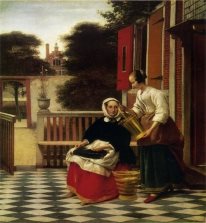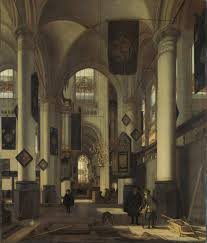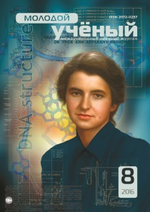The 17th century — the period of formation of national schools of painting, sculpture and architecture in the countries of Western Europe, including Holland and France. Main achievements of Dutch art culture in the 17th century is connected neither with architecture nor with sculpture but with painting. The 17th century was its golden age. Taking into consideration the modest dimensions of the interior of Dutch houses the pictures of that period were painted in small size. Painting became the favourite art of the Dutch, as it was able to reflect reality in huge reliable and varied manner. The Dutch wanted to see in pictures what was familiar to them — nature of their country, sea, their own life and house, the things surrounded them.
The life of the personages of Dutch painters’ pictures proceeds inside a house — in the rooms or in the small yard which forms a part of the house and is perceived as one of its interior as well. But interior in these pictures is not only the place of action: it is an area where a man lives. Dutch painters aspired to create an atmosphere of interior so as a spectator penetrates the life of people of the definite circle, its character, its “aroma.”
This as if physically palpable inner connection of interior and man defined originality of the best works of Dutch genre art, first of all, the compositions of Pieter de Hooch (1629–1689). In his art exactly environment — interior, space, air and light, its additions — carry the main melody, exactly through the feeling of surroundings we contact with intimate poetry of the modest urban life. In the picture “The Mistress and Maidservant” (the second half of the 50s, St. Petersburg, Hermitage) the women are talking slowly, life in this house and around it goes on quietly. The trees don’t stir, it is quiet in the street where a couple is walking along the canal.

Fig. 1. P. de Hooch. The Mistress and Maidservant. The second half of the 1650s. St. Petersburg, Hermitage
In the picture “At the Pantry Entrance” (about 1658, Amsterdam, Rijksmuseum) the peaceful atmosphere of home, surrounding a spectator with quiet and coziness, is created by “mood” of interior, inspired by sunlight and presence of mother and child. The main theme of genre scenes of P. de Hooch becomes life itself. In the picture “The Yard” (ab.1658, London, the National Gallery) it is reproduced by wonderful sense of touch and sharp feeling of its soft poetic charm. Perhaps in the works of genre art peculiarities of art world perception and creative method of Dutch masters and conquests and losses connected with it are discovered clearer.
Extreme breaking up, differentiation of subjects and genre forms limited the tasks of Dutch art at that time — otherwise, both direct reflection of surrounding reality and concrete creation of its varied phenomena were impossible. And besides, the Dutch masters comprehended and valued all phenomena by the position of private man, from the point of view of private life — it is the cause of historical natural peculiarity of Dutch art culture, hence its chamber, intimate character.
However, while interpreting this theme painters, often, were satisfied with external side of phenomena — they didn’t analyze them, didn’t reveal their essence. The painters lost ability of creation generalizing images, putting important problems on the material of modern life. In their art when painting was at the height of its development pathos of new Holland and its hero often turned out urban limitation. Not accidentally the name “petty Dutchmen”, which Dutch masters were called for small size of their pictures and intimate character of explanation of a theme, included the second meaning too. In the middle and second half of the 17th century, in the new historical period of development of Dutch republic, narrowness of ideological and spiritual horizons, often habitual to “petty Dutchmen”, became especially obvious. Social contradictions of bourgeois system came to light with-all its frankness and depths at that time. Self- satisfied and rich bourgeoisie was not a bearer of advanced social ideals. Having got rich many urban people left their works in order to enjoy luxury of care-free life. Now patrician top presented other demands for art — representation, idealization, decorative effect. Tremendous success of B.van der Helst’s s gala portraits or smart landscapes, representing beauty of southern nature arises from it. Italianizating masters oriented themselves to the choice of motives and their picturesque interpretation on Italian models were becoming fashionable. The best works in Dutch painting of those years were often contrary to the demands and tastes of bourgeois circles whose ideals gradually, but more and more definitely, contradicted the realistic rush of advanced Dutch art.
While the development of Dutch society (from the 40s to the 70s) Dutch painting rose at its height. Complicated matter of historical moment defined diversity and significance of its problematic: it demanded from the painting the great spiritual mature, deeper sense of reality, dictated it the necessity of passing to wide art generalization from the separate phenomenon, private motive and fact. Dutch portrait, landscape and genre art obtained new features.
The landscape painters of the second generation — excluded Goyen and his contemporaries who were engaged in truth transference of motive,- aspired to give landscape more generalized and grand character (Philip Coninko’s plain landscapes) and to show nature more corporal, physical, nearer and more directly (forest landscapes of M.Hobbem). Figured staff age hadn’t already played an important role in landscape — the life of nature obtained significance which was independent from man.
Landscape painting was risen to special height by Jacob van Ruisdael’s creative work (1628/29–1682). He painted nature in special significance and might. Each detail — trunk of tree, branches, leaves, hills or bushes -is transferred with its disposition, great material conviction and at the same time is done with such expressive power and has such important significance in composition that it becomes embodiment of present natural form: landscape obtains epic grandeur (“The River in the Forest”, 1660, St. Petersburg, Hermitage).
The new period of development of Dutch genre painting is connected with the creative activity of masters of Delft school — the group of painters worked in Delft in the 50–60s of the 17th century. C. Fabricius, E.de Vitte and J.Vermeer were the best of them.
C.Fabricius’s pictures “The Shop-Assistant of Musical Instruments” (1652, London, the National Gallery) and “The Sentry” (1654, Shverin, the Museum) became important landmarks in the evolution of genre painting. Their matter isn’t exhausted by statement of aesthetic value of insignificant everyday episode — Fabricius wanted to tear himself away the captivity of limited, urban world perception, wanted man and world to live in unity. In London composition he combines life scene, landscape and still-life — thanks to it the work gets huge versatility. In “The
Sentry”, unlike the works of other Dutch genrists, man plays an important and enough independent part. Besides, the painter achieved here complete inner joint of man and environment. In Fabricius’s pictures, sadness and loneliness sounded for the first time in Dutch genre painting.
Aspiration to embody higher aesthetic ideals to genre picture demanded the search of new expressive means. The painter’s experiences in the field of space construction and daylight transference served for this aim. Fabricius’s creative work highly influenced on many masters worked in Delft including P.de Hooch who created his best works just here in the 50–60s.
Genre painting obtained new image matter in the art of Emmanuel de Vitte (1617–1692). In the compositions on the topic “Fish Markets” the painter leads genre art out of the house to town space, to social life. Laconism and breadth of picturesque style — expressive lines, generalized colour spots — give “Markets” monumental character.
In the composition “ The Woman at the Clavecin” (ab. 1668, Rotterdam) elevated perspective reduction draws space plans together, suite of rooms involves spectator’s look to depths, not in measure gradually, but in fast condensed rhythm; in a subtle underlined contrasts of rich hues, in the rhythm of shade and light spots anxiety lies hidden. In the emotional tone of the work hidden strain is caught.
In E.de Vitte’s creative work the picture of church interior also joins interior genre scenes — a special view of architectural picture developed in Holland. Usually E.de Vitte depicted a part of interior out of interior space concentrates its specificity, originality of the building architecture in itself. “Condensation” of compositional construction and close point of view gives the motive significance and grandeur, and sharp changes of space plans, complex rhythmical structure part the composition with dynamic sharpness and strain intensify light — play inside church. The light which the painter gave in various nuances carries romantic note in spiritual atmosphere of picture — poetic outburst, leaving for the sphere far from every-day prose. The beauty of colour keeps poetic construction of the work.

Fig. 2. E. de Vitte. The Interior of Gothic Church. 1680–1682. Amsterdam, Rijksmuseum
E.de Vitte managed to create the second mysterious and inspired life of interior rich in emotional shade, life of architecture, which throws its elevated reflection on the existence of people who are absorbed in daily fuss and usual care. Art of Jan Vermeer van Delft (1632–1675) is close to C. Fabricius’s and E.de Vitte’s ones, but everything created by this great painter is unusually original.
A mature master Vermeer showed his talent in his early picture “At the Arch” (1656, Dresden, the Picture Gallery). It struck with brightness and full-bloodedness of characters, monumentalism of forms, holiday colours (intensive red, yellow, green, black and white colours placed in large planes) which exist in Dutch genre painting.
Later on Vermeer refused expressive-characteristic types and situations, which consist one of the important features of the picture “At the Arch”; as a rule, he didn’t work in such big size any more. Vermeer discovered himself in another thing. But, remained faithful to the subjects traditional for Dutch genre art, he gave them absolutely new, spiritual sense.
Vermeer’s genre compositions usually depict one or two figures (mainly female) in the interior of Dutch house. He equalized all individual features in his personages — this is a variation of generalized impersonal image — a type called to concentrate sense and spirit of the work in itself.
References:
- Беляцкая B. П. Пособие по английскому языку для художественных вузов и факультетов, Mocквa, “Bысшая школа”, 1974
- Пpycc И. E., Maлая история искусств. 3aпaдно — eвpoпeйское иcкyccтвoXVII вeкa, VebVerlagderKunstDresden, 1974; “Искусство”, Mocквa, 1974
- Poтeн6epr E. И., Голландское искусство XVII вeкa, Mocквa, 1972
- The World Book Encyclopedia, V. 1, 7, 9, 15, Chicago London Sydney Toronto, 1994







